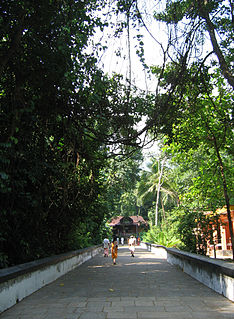| Tiwaf | |
|---|---|
 Tiwaf (Tawwaf) in Bashiqa, Iraq | |
| Observed by | Yazidis |
| Type | Religious |
| Part of a series on the Yazidi religion Yazidism |
|---|
 |
A tiwaf is a type of religious festival in Yazidism.
| Tiwaf | |
|---|---|
 Tiwaf (Tawwaf) in Bashiqa, Iraq | |
| Observed by | Yazidis |
| Type | Religious |
| Part of a series on the Yazidi religion Yazidism |
|---|
 |
A tiwaf is a type of religious festival in Yazidism.
Tiwafs are accompanied by numerous rituals which vary from shrine to shrine. These rituals may include performances of the qewwals with their musical instruments, changing and renewing of the coloured strips of cloth (perî) that hang from the spire of the shrine, ritual meals either for the heads of the households or for the whole village, or cooked parts of the sacrificial sheep being auctioned off to bidders among the cheering crowd. The tiwafs in other places also include trips into nature to reach a sacred spot, lending an air of picnic to the occasion, one example is during the tiwaf at the shrine of Kerecal near Sharya, which takes place on a mountain, or at the sacred place of Sexrê Cinê located deep inside the Valley of Jinn near Bozan. In many places, large and communal dances are also included in the tiwafs. Tiwafs are not necessarily attended solely by the locals of the village itself, the participants may also include many of the other Yazidis, particularly the ones who have relatives in the village or have a special attachment with the holy being to which the shrine is dedicated. Together with keeping the Yazidi religious customs alive, tiwafs also serve to strengthen the social ties between families and the communal solidarity, both on the village and inter-village levels. [1] [2]

Shinto is a religion that originated in Japan. Classified as an East Asian religion by scholars of religion, its practitioners often regard it as Japan's indigenous religion and as a nature religion. Scholars sometimes call its practitioners Shintoists, although adherents rarely use that term themselves. Shinto has no central authority in control, and much diversity exists among practitioners.

An altar is a structure with an upper surface for the presentation of religious offerings, for sacrifices, or for other ritualistic purposes. Altars are found at shrines, temples, churches, and other places of worship. They are used particularly in Paganism, Christianity, Buddhism, Hinduism, Judaism, and Modern Paganism. Many historical faiths also made use of them, including the Roman, Greek, and Norse religions.

A shrine is a sacred or holy space dedicated to a specific deity, ancestor, hero, martyr, saint, daemon, or similar figure of respect, wherein they are venerated or worshipped. Shrines often contain idols, relics, or other such objects associated with the figure being venerated. A shrine at which votive offerings are made is called an altar.

Sacred groves or sacred woods are groves of trees and have special religious importance within a particular culture. Sacred groves feature in various cultures throughout the world. They were important features of the mythological landscape and cult practice of Celtic, Estonian, Baltic, Germanic, ancient Greek, Near Eastern, Roman, and Slavic polytheism; they also occur in locations such as India, Japan, and West Africa. Examples of sacred groves include the Greco-Roman temenos, various Germanic words for sacred groves, and the Celtic nemeton, which was largely but not exclusively associated with Druidic practice. During the Northern Crusades of the Middle Ages, conquering Christians commonly built churches on the sites of sacred groves. The Lakota and various other North American tribes regard particular forests or other natural landmarks as sacred places. Singular trees which a community deems to hold religious significance are known as sacred trees.

Yazidism or Sharfadin is a monotheistic ethnic religion that has roots in a western Iranic pre-Zoroastrian religion directly derived from the Indo-Iranian tradition. Yazidism is followed by the mainly Kurmanji-speaking Yazidis and is based on belief in one God who created the world and entrusted it into the care of seven Holy Beings, known as Angels. Preeminent among these Angels is Tawûsê Melek, who is the leader of the Angels and who has authority over the world.

Parikrama or Pradakshina is clockwise circumambulation of sacred entities, and the path along which this is performed, as practiced in the Indic religions - Hinduism, Buddhism, Sikhism and Jainism. In Buddhism, it refers only to the path along which this is performed. Typically, in Indic-religions the parikrama is done after completion of traditional worship and after paying homage to the deity. Parikrama must be done with dhyāna.

Kagura is a specific type of Shinto ritual ceremonial dance. The phrase is a contraction of "kami no kura ", indicating the presence of god in the practice. One major function of Kagura is "Chinkon .", involving a procession-trance process. Usually a female shaman will perform the dance and obtain the oracle from the god----in the setting, the dancer herself turns into god during the performance. Once strictly a ceremonial art derived from kami'gakari, kagura has evolved in many directions over the span of more than a millennium. Today, it is very much a living tradition, with rituals tied to the rhythms of the agricultural calendar, thriving primarily in parts of Shimane Prefecture, and urban centers such as Hiroshima.

The Tai folk religion, or Satsana Phi, or Ban Phi is a form of animist religious beliefs intermixed with Buddhist beliefs traditionally and historically practiced by groups of ethnic Tai peoples.

A yorishiro (依り代・依代・憑り代・憑代) in Shinto terminology is an object capable of attracting spirits called kami, thus giving them a physical space to occupy during religious ceremonies. Yorishiro are used during ceremonies to call the kami for worship. The word itself literally means "approach substitute". Once a yorishiro actually houses a kami, it is called a shintai. Ropes called shimenawa decorated with paper streamers called shide often surround yorishiro to make their sacredness manifest. Persons can play the same role as a yorishiro, and in that case are called yorimashi or kamigakari.

Yazidis or Yezidis are a Kurmanji-speaking endogamous minority group who are indigenous to Kurdistan, a geographical region in Western Asia that includes parts of Iraq, Syria, Turkey and Iran. The majority of Yazidis remaining in the Middle East today live in Iraq, primarily in the governorates of Nineveh and Duhok. There is a disagreement among scholars and in Yazidi circles on whether the Yazidi people are a distinct ethnoreligious group or a religious sub-group of the Kurds, an Iranic ethnic group. Yazidism is the ethnic religion of the Yazidi people and is monotheistic in nature, having roots in a pre-Zoroastrian Iranic faith.
Norse religious worship is the traditional religious rituals practiced by Norse pagans in Scandinavia in pre-Christian times. Norse religion was a folk religion, and its main purpose was the survival and regeneration of society. Therefore, the faith was decentralized and tied to the village and the family, although evidence exists of great national religious festivals. The leaders managed the faith on behalf of society; on a local level, the leader would have been the head of the family, and nationwide, the leader was the king. Pre-Christian Scandinavians had no word for religion in a modern sense. The closest counterpart is the word sidr, meaning custom. This meant that Christianity, during the conversion period, was referred to as nýr sidr while paganism was called forn sidr. The center of gravity of pre-Christian religion lay in religious practice — sacred acts, rituals and worship of the gods.

Indigenous Philippine shrines and sacred grounds are places regarded as holy within the indigenous Philippine folk religions. These places usually serve as grounds for communication with the spirit world, especially to the deities and ancestral spirits. In some cases, they also function as safeguards for the caskets of ancestors, as well as statues or other objects depicting divine entities.

The Ryukyuan religion (琉球信仰), Ryūkyū Shintō (琉球神道), Nirai Kanai Shinkō (ニライカナイ信仰), or Utaki Shinkō (御嶽信仰) is the indigenous belief system of the Ryukyu Islands. While specific legends and traditions may vary slightly from place to place and island to island, the Ryukyuan religion is generally characterized by ancestor worship and the respecting of relationships between the living, the dead, and the gods and spirits of the natural world. Some of its beliefs, such as those concerning genius loci spirits and many other beings classified between gods and humans, are indicative of its ancient animistic roots, as is its concern with mabui (まぶい), or life essence.

A pura is a Balinese Hindu temple, and the place of worship for adherents of Balinese Hinduism in Indonesia. Puras are built in accordance to rules, style, guidance and rituals found in Balinese architecture. Most puras are found on the island of Bali, where Hinduism is the predominant religion; however many puras exist in other parts of Indonesia where significant numbers of Balinese people reside. Mother Temple of Besakih is the most important, largest and holiest temple in Bali. Many puras have been built in Bali, leading it to be titled "the Island of a Thousand Puras".

Kottiyoor Temple is a prominent Shiva temple in Kottiyoor, Kannur, Kerala,India. Vadakkeshwaram Temple is the common name of the temple from ancient times, but some of the local people address the temple as Ikkare Kottiyoor as it is on the bank of the river close to the Kottiyoor village, to differentiate it from the shrine in the other side of the river. Thruchherumana Kshetram is also another name by which temple is known. The temple is a special category temple under Malabar Devaswom board.
There is a social organizational structure in the Yazidi community. There are three main castes, namely the Mirids, the Sheikhs, and the Pirs. Furthermore, there are positions for dignitaries in the Yazidi hierarchy.
Folk practices prevalent in Punjab incorporate local mysticism and refers to the beliefs and practices strictly indigenous to the Punjabi people, of the Punjab region including ancestral worship, veneration of saints, and local festivals. There are many shrines in Punjab which represent the folk religion of the Punjab region which is a discourse between different organised religions. These shrines represent inter-communal dialogue and a distinct form of cultural practice of saint veneration.

A dap-ay, ato, or ator (Bontoc) is a paved raised ceremonial platform ringed with stone seats and with a central fireplace among the Cordilleran cultures in the northern Philippines. It primarily serves as a venue for meetings and public forums between the council of elders. It is the social, religious, and political center of a certain group of families within a village. The term itself is also used to refer to the indigenous process of decision-making by the elders, or to the council of elders themselves. Dap-ay also usually contain traditional dormitories for young boys in the village.

The Feast of the Assembly is a Yazidi festival.